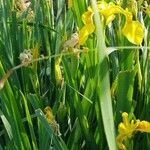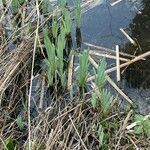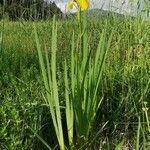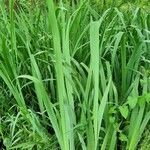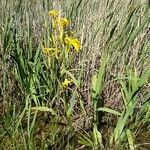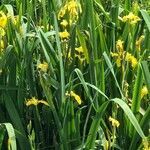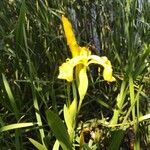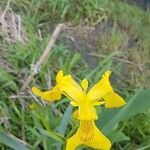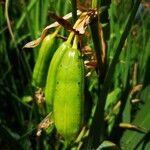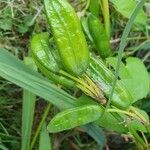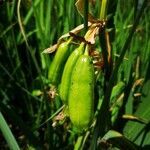Clumps very leafy, many-flowered, to 1 m high, dark green, ± glaucous, purple at base. Rhizome c. 3 cm diam., reddish-brown. Leaves c. = stems, 2-3 cm wide, cross-veinlets apparent when leaf is held up to light, midrib distinct. Stems terete, with several long leaves. Inflorescence usually branched, central axis and each branch terminated by 2-5-flowered clusters. Flowers to 12 cm diam., yellowish, varying from golden-orange to very pale cream, without scent; pedicels long, stout, > ovary; tube funnel-shaped, ± ½ length of ovary; outer segments 7 cm long, oval-oblong, limb c. 4 cm wide, very drooping, abruptly narrowed to dark brown-veined claw; inner segments c. 3 cm long, shorter and narrower but more erect than style-branches. Style-branches oblong, bifid crest fimbriate. Capsule c. 5 × 2 cm, oblong-elliptic, beaked; seeds brown, ± trigonous.
Lvs stiff and erect, broadly ensiform from densely crowded rhizomes; stem 0.5–1 m, shorter than or equaling the lvs; fls 7–9 cm wide, bright yellow or cream-color; sep spreading, the crest area outlined by an irregular series of brown markings; pet erect, ligulate, constricted at the middle, 1–2.5 cm, unmarked; capsule 6-angled, cylindric-prismatic to ellipsoid, 5–8.5 cm, the valves widely spreading at maturity; 2n=24–34. Swamps and shallow water along streams and ponds; native of Europe, and widely established in our range. Apr.–June.
A perennial plant. It grows 90-150 cm high and 30-45 cm wide. It is a beardless iris. It has rhizomes. The leaves are blue-green. They are strong and stiff and sword shaped. They are 2.5 cm wide and 1 m long. The flowers are yellow. They are 8-9 cm across. They have brown veins which radiate out and an orange spot near the throat. The seeds are flat and float.
